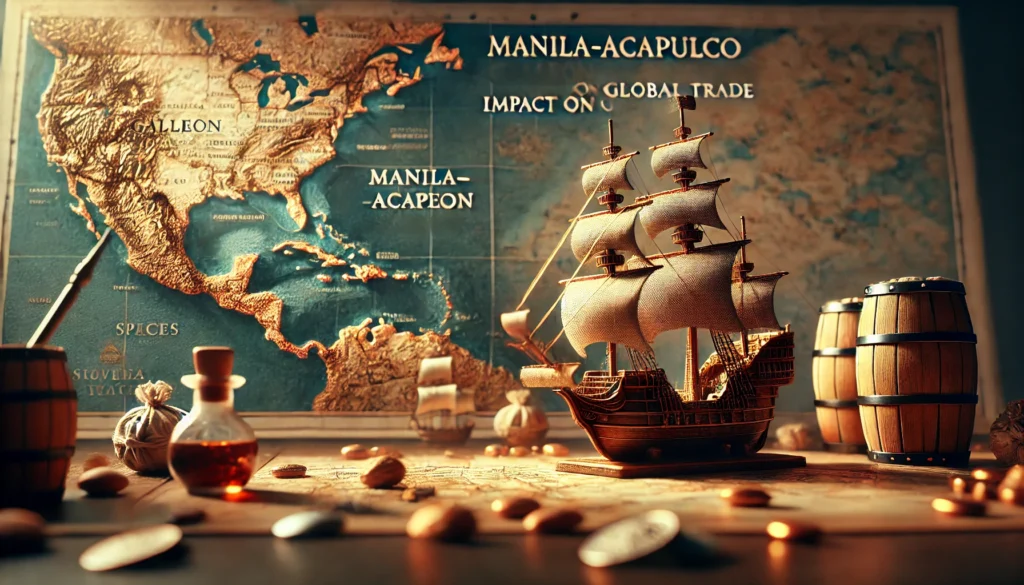The Manila-Acapulco Galleon Trade, also known as the Manila Galleon Trade or the Mexican-Philippine Trade, was one of the most significant and long-lasting trade routes in history. This maritime commercial system connected Asia, America, and Europe for nearly 250 years, from 1565 to 1815. The trade route was established shortly after the Spanish colonization of the Philippines, following Miguel López de Legazpi’s expedition in 1565.
Spanish Colonial Ambitions
Spain’s primary motivation for establishing this trade route was to gain access to the lucrative Asian spice trade, which was dominated by the Portuguese at the time. By creating a direct link between their colony in the Philippines and their territories in New Spain (present-day Mexico), the Spanish sought to bypass Portuguese-controlled trade routes and establish their own foothold in the Asian market.
Key Figures in Establishing the Trade
Several key figures played crucial roles in the establishment of the Galleon Trade:
- Miguel López de Legazpi: The Spanish navigator who led the expedition to colonize the Philippines in 1565.
- Andrés de Urdaneta: A Spanish friar and explorer who discovered the return route from the Philippines to Mexico, known as the “tornaviaje.”
- Juan Pablo de Carrión: A Spanish naval officer who helped establish the first trade regulations between Manila and Acapulco.
The Mechanics of the Galleon Trade
The Route and Its Challenges
The Manila-Acapulco Galleon Trade followed a specific route across the Pacific Ocean:
- Outbound journey (Manila to Acapulco): Typically lasting 4-5 months
- Return journey (Acapulco to Manila): Usually taking 6-8 months
The journey was fraught with dangers, including storms, piracy, and disease. The vast distances covered and the unpredictable nature of ocean travel made this one of the most challenging trade routes of its time.
Frequency and Volume of Trade
Initially, the trade was conducted annually, with one or two galleons making the round trip each year. As the trade grew in importance and volume, the frequency increased:
| Period | Number of Galleons per Year |
|---|---|
| 1565-1593 | 1-2 |
| 1593-1720 | 2 (officially limited) |
| 1720-1815 | 1-2 (varied) |
The volume of trade was significant, with each galleon carrying goods worth millions of pesos. By the 18th century, the annual value of goods traded often exceeded 2 million pesos.
Types of Goods Traded
The Galleon Trade facilitated the exchange of a wide variety of goods:
- From Manila to Acapulco:
- Silks and other textiles
- Spices (pepper, cinnamon, cloves)
- Porcelain
- Ivory
- Jade and other precious stones
- Lacquerware
- Gold and silver objects
- From Acapulco to Manila:
- Silver (primarily from Mexican mines)
- Agricultural products (cocoa, coconut oil, seeds)
- European manufactured goods
- New World products (tobacco, chocolate, coca)
Economic Impact of the Galleon Trade
Global Market Integration
The Manila-Acapulco Galleon Trade played a crucial role in integrating global markets. It connected three continents – Asia, America, and Europe – creating a complex web of economic relationships. This trade route facilitated the exchange of not only goods but also ideas, technologies, and cultural practices.
Silver Flow and Its Consequences
One of the most significant economic impacts of the Galleon Trade was the massive flow of silver from the Americas to Asia. This had far-reaching consequences:
- Inflation in China and other parts of Asia due to the influx of silver
- Stimulation of silver mining in the Americas, particularly in Mexico and Peru
- Creation of a global silver standard for trade
Impact on Local Economies
The Galleon Trade had profound effects on the local economies involved:
- Philippines: Became a major entrepôt for Asian goods, but experienced limited economic development beyond Manila
- Mexico: Acapulco emerged as a significant port city, while inland cities like Mexico City benefited from the trade
- Spain: Gained access to Asian luxury goods and strengthened its position in global trade
Social and Cultural Exchange
Population Movements and Cultural Mixing
The Galleon Trade facilitated significant population movements and cultural exchanges:
- Chinese merchants and artisans settled in Manila, forming a large and influential community
- Filipino sailors and workers traveled to Mexico, some settling permanently
- Spanish and Mexican influences became evident in Philippine culture and vice versa
Exchange of Ideas and Technologies
The trade route served as a conduit for the exchange of knowledge and technologies:
- Agricultural techniques and crops were shared between the Philippines and Mexico
- Asian textile production methods influenced Mexican artisans
- European and American ideas and practices were introduced to the Philippines
Religious and Linguistic Influences
The Galleon Trade also facilitated religious and linguistic exchanges:
- Spread of Catholicism in the Philippines
- Introduction of Spanish language elements into Filipino languages
- Incorporation of Asian and American words into Spanish vocabulary
Political and Strategic Implications
Strengthening Spanish Colonial Power
The Manila-Acapulco Galleon Trade played a crucial role in consolidating Spanish colonial power in the Philippines and the Americas. It provided the economic backbone for Spanish rule in the Philippines and helped finance colonial administration and military operations.
International Rivalries and Conflicts
The lucrative nature of the Galleon Trade attracted the attention of other colonial powers:
- Dutch and English attempts to disrupt the trade through piracy and naval attacks
- Increased military presence in the Pacific to protect the trade route
- Diplomatic tensions between Spain and other European powers over trade rights
Impact on Indigenous Populations
The Galleon Trade had significant consequences for indigenous populations:
- Disruption of traditional economic systems in the Philippines
- Exploitation of indigenous labor in both the Philippines and Mexico
- Introduction of new diseases to populations with little immunity
Technological Advancements in Navigation and Shipbuilding
Improvements in Ship Design
The challenges of the Pacific crossing led to advancements in shipbuilding:
- Development of the Manila galleon, a unique ship design optimized for the long Pacific voyage
- Innovations in hull construction and rigging to withstand storms and carry large cargo volumes
Navigational Techniques
The Galleon Trade contributed to the refinement of navigational techniques:
- Improved methods for calculating longitude at sea
- Better understanding of Pacific Ocean currents and wind patterns
- Development of more accurate maps and charts of the Pacific
Environmental Impact and Ecological Exchange
Introduction of New Species
The Galleon Trade facilitated the movement of plant and animal species across the Pacific:
- Introduction of American crops (e.g., corn, tomatoes, potatoes) to the Philippines
- Spread of Asian fruit trees and spices to the Americas
- Unintentional transfer of pests and pathogens
Resource Exploitation
The trade had significant environmental impacts:
- Deforestation in the Philippines for shipbuilding and to clear land for cash crops
- Increased mining activities in the Americas to supply silver for the trade
- Overexploitation of certain species (e.g., sea cucumbers) to meet trade demands
Decline and Legacy of the Galleon Trade
Factors Contributing to Decline
Several factors led to the eventual decline of the Manila-Acapulco Galleon Trade:
- Increased competition from other European powers in Asian trade
- Opening of new trade routes, particularly after the independence of Latin American countries
- Reforms in Spanish colonial policy, including the liberalization of trade
- Technological advancements in shipping that made the galleon system obsolete
End of the Trade
The Galleon Trade officially ended in 1815, marking the close of a 250-year era. The last galleon, the San Fernando (Magallanes), made its final voyage in 1815.
Lasting Legacy
Despite its end, the Manila-Acapulco Galleon Trade left a lasting legacy:
- Established patterns of global trade that would shape future economic relationships
- Created enduring cultural connections between Asia, the Americas, and Europe
- Contributed to the development of international maritime law and practices
- Laid the foundation for future transpacific trade and cultural exchange
The Galleon Trade in Modern Perspective
Historical Significance
The Manila-Acapulco Galleon Trade is now recognized as a crucial chapter in the history of globalization. It represents one of the earliest examples of sustained, large-scale intercontinental trade, predating the more familiar trade networks of the Industrial Revolution era.
Academic Interest and Research
In recent years, there has been renewed academic interest in the Galleon Trade:
- Archaeological studies of shipwrecks and trade goods
- Analysis of the trade’s impact on global economic history
- Exploration of cultural exchanges facilitated by the trade
Contemporary Relevance
The legacy of the Galleon Trade continues to influence contemporary relations:
- Cultural ties between the Philippines, Mexico, and Spain
- Ongoing economic connections across the Pacific
- Historical context for current debates on globalization and trade
Conclusion: The Enduring Impact of a Maritime Marvel
The Manila-Acapulco Galleon Trade stands as a testament to human ingenuity, courage, and the relentless pursuit of economic opportunity. For nearly two and a half centuries, this maritime trade route connected vastly different cultures, economies, and ecosystems, leaving an indelible mark on global history. Its impact on world trade, cultural exchange, and technological advancement cannot be overstated.
As we reflect on this remarkable chapter of history, we gain valuable insights into the roots of our modern globalized world. The challenges and triumphs of the Galleon Trade continue to resonate today, offering lessons in international commerce, cultural diplomacy, and the complex interplay between economic ambition and human resilience.
The story of the Manila-Acapulco Galleon Trade serves as a powerful reminder of how trade can shape civilizations, foster innovation, and create lasting connections across vast oceans and diverse cultures. It remains a fascinating subject for historians, economists, and anyone interested in the grand tapestry of global history.
Disclaimer: This article aims to provide accurate and up-to-date information on the Manila-Acapulco Galleon Trade based on historical records and research available up to 2023. However, as new discoveries and interpretations may emerge, readers are encouraged to report any inaccuracies or outdated information. Your feedback will help us maintain the accuracy and relevance of this content. Thank you for your contribution to the ongoing exploration of this important historical topic.




